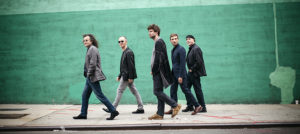Tom Clancy on the unlikely grouping and wonders of The Gloaming
One online dictionary notes that few English speakers will know the meaning of the word gloaming. The rapt audience at the Freight & Salvage in Berkeley on November 12, 2014, will remember it from the brilliant performance of the word made flesh in The Gloaming. This band of creative peers is led by Irish fiddler Martin Hayes and sean-nos singer Iarla O’Lionaird, and they were superbly supported by Dennis Cahill on guitar, Caoimhin O’Raghallaigh on hardanger fiddle, and Thomas Bartlett on piano. They would vehemently resist the dubious soubriquet but the term Super Group – often bandied about to describe various Irish musical combinations — is apt.
On any given night at the Freight, half the audience is likely to be musicians and when Martin Hayes plays that ratio increases. He and O’Lionaird are responsible for more back-of-the-neck hair-raising experiences than any other contemporary Irish artists. Many Freight people heard him sing for the first time when he appeared along with Hayes at The Masters of the Tradition concert in 2013 and were awed by the voice that soars and swoops beautifully.
The concert featured most of the music from their first CD. The cover has an image of a man who appears to be traversing a bridge while building it. It’s a useful metaphor for the band’s ongoing creation of a crossover space between the protected structures of the Irish tradition and the more improvisational patterns of contemporary music. There are respectable precedents. Fiddler Paddy Glackin and multi-instrumentalist Jolyon Jackson undertook a careful de-construction of traditional tunes with the album Hidden Ground back in 1980. The Girl Who Broke My Heart has clear sonic echoes of that earlier artful adventure without the use of electronic instrumentation.
The Gloaming are an unlikely grouping. O’Lionaird and Hayes are acclaimed traditional masters and Cahill has been Hayes’ musical partner for many years. O’Raghallaigh is a younger player who has been happily pushing the trad envelope for years. He provides the generational and venturesome connective tissue in the band with Bartlett, another youngster. Bartlett has no grounding in traditional music -a decided advantage for his role in the band, according to him. He is fond of throwing shapes at the piano, channeling Glenn Gould with flashes of Jerry Lee Lewis.
Opening Set builds quite a head of steam and reaches into Bothy Band territory. Bartlett provides a backdrop with classical variations. Hayes takes off into one of his patented rhapsodies with the guitar in pursuit. The plaintive voice is underlined by the hardanger. Hunting the Squirrel is like one of those Irish showers that arrives as a mist on one hill, blooms into a symphonic downpour before drifting away over the next hill. Allistrum’s March is one of the more mainline traditional renditions but Bartlett’s backing stays on the right side of dissonance, resisting the urge to overwhelm the melodic fiddle.
Iarla O’Lionaird has a central role in the band. He filters the “sean-nos” canon through a deeply musical sensibility, touched by his work with new music composers in Ireland and –dare I say it- his pop/rock entertainment experience with the Afro-Celt Sound System. Song 44, belies its plain title to make a spectral journey from the lower reaches to the lyrical heights. Samhraidh, Samraidh/Summer, Summer and Saoirse/Freedom are gorgeous showcases for his voice. The lyrics are adapted from Saoirse by Irish poet Seán O’Riordáin. The Necklace of Wrens is from a seminal poem by the late Michael Hartnett. O’Raghallaigh mentioned that Hartnett can be heard talking about the poem’s creation story in a YouTube clip
Some sets started with just a wisp of a melody, fragments that ultimately flow and flower in the ensemble. Sometimes Hayes and O’Raghallaigh play in unison but with the range of the hardanger it often sounds other-worldly. Then, there are the different fiddle-playing styles: in full-flight Hayes’ body seems possessed by the music while O’Raghallaigh tends towards stillness rather like Kevin Burke.
The core of their music is traditional but The Gloaming introduces tones, textures and variations that extend from that solid base. If you start with enough musical empathy, Hayes says of the band’s origins, the results will always be worthwhile as long as you get out of the way to let the music come through. It seems futile to pin a genre on what they are doing, it’s just a magical musical mash-up to savor. And, like all the music from Hayes and Cahill, it is best experienced in a live setting where the sounds and sights take on their full significance.



